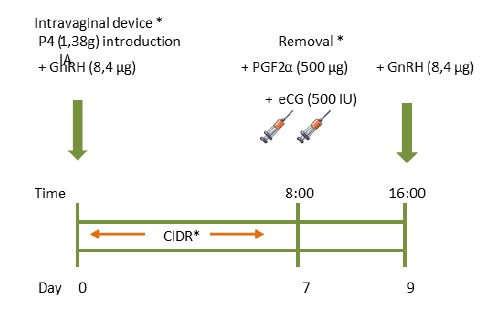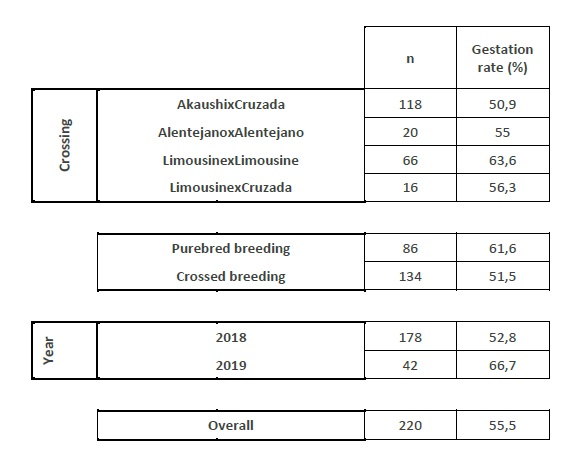Introduction
Extensive animal production systems are defined as those in which animals with their own characteristics are used, well adapted to the conditions of the environment and to food produced locally (Vaz Portugal, 1990).
According to Baruselli (2007), to optimize production, the goal is that each cow weans one calf per year.
Producers usually report that their cows produce a calf every year, not mentioning, however, that calving occurs both in June and in November, that is, the interval between the two calves is greater than 365 days (Romão e Bettencourt, 2009).
In the animal production industry, it is recognized that one of the biggest economic problems is in reproductive inefficiency, so assisted reproduction can increase the reproductive efficiency of cows, especially in an extensive system. The establishment of reproductive seasons, in addition to the practical component of improvement in animal husbandry and greater profitability of working time, can guarantee better body condition at birth and greater milk production. Lopes da Costa (2008) states that “the establishment of defined breeding seasons, in order to adjust the best food availability to the critical periods of the female reproductive cycle is probably the most relevant step towards obtaining good reproductive efficiency”.
Thus, the maximum yield will be obtained with the adoption of measures such as, in terms of pasture management or application of biosafety plans but paying special attention to improving the reproductive performance of its herds, namely through the adoption of reproductive techniques that can adapt to the management defined in each farm, improving reproductive and productive indexes.
Short et al. (1990) refer that the production in beef cattle has the biggest limiting factor in reproduction, whereas according to Silva (2011), the economic profitability of the national beef cattle industry depends almost exclusively on the sale of produced calves, which gives reproductive factors high importance.
According to Brash (1994), artificial insemination (AI) has also proved to be useful in accelerating the transfer of genetic gains from commercial herds.
In Portugal AI is not a common practice in beef cattle, in other countries it is widely used and associated with synchronization methods to facilitate management and reduce the need for detection of estrus, since the synchronization of estrus or ovulation allows AI and batch deliveries, facilitating management, being particularly important in groups of replacement heifers and in cows that are breastfeeding.
With this study we intend to evaluate the use of fixed-time artificial insemination (TAI) in beef cattle, exploited in extensive production systems, in the interior of Portugal.
1. Methods
Between March 2018 and April 2019, a total of 220 TAIs were carried out on eight different farms, 118 females of indeterminate breed inseminated with semen of Akaushi breed, 82 females of Limousine breed with semen of Limousine and 20 females of Alentejana breed with semen of Alentejana.
Visits were made to the farms to select the females to be synchronized and inseminated, according to the stipulated protocol. First, an identification form for each of the females was filled out with elements considered important for their selection, such as: age; postpartum days; postpartum problems; treatment/ illness occurrence; vaccination/ deworming protocols.
Subsequently, a physical examination was performed on each female, assessing her general condition (level of consciousness, behavior, posture, movement), body condition (BC ≥ 4.5, ideal according to Silva (2011), on a scale of 1-9) and evaluation of the reproductive tract by transrectal palpation (detection of pathologies of the reproductive tract, uterine involution, pregnant females and mummified fetuses).
The cows selected for the study were subjected to a modified CO-Synch type ovulation induction protocol (Figure 1). This protocol consisted of the administration of 8.4 (g of a GnRH analogue [buserelin acetate, Receptal®, MSD Animal Health (Intervet Portugal - Saúde Animal Lda), Portugal] and the introduction of an intravaginal device [1.38g of P4 , CIDR®, Pfizer Saúde Animal (Intervet Portugal - Saúde Animal Lda), Portugal] on a random day of the female ovarian cycle (day 0), with removal of the intravaginal device and administration of 500 (g of a PGF2α analogue [Cloprostenol sodium , Estrumate®, MSD Animal Health (Intervet Portugal - Saúde Animal Lda), Portugal] and 500 IU eCG [Intergonan 6000 UI®, Animal Health (Intervet Portugal - Saúde Animal Lda), Portugal] after 7 days (day 7) and IA, associated with a new administration of 8.4g of the GnRH analogue, 48 hours later (day 9).
One of the greatest advantages of this type of protocols is that it is effective in cases of anestrus since it is capable of inducing cyclicality in cows or non-cyclical heifers.
AI was carried out with due hygienic care and respecting the welfare of the females to be inseminated. Not all animals were evaluated and registered by the work team. Some females were selected by the owners of the animals, so on the day of AI there was a need to reject animals due to the presence of an intravaginal device, animals closed in pens without available water, weak BC (≤ 3), young females, and later for having a body inactive corpus lute (did not respond to the synchronization protocol). The pregnancy diagnosis was performed 40 days after TAI by ultrasound.
2. Results and discussion
The gestation rate (%G) for the total TAI was 55.5%, varying between 52.8% (n = 178) and 66.7% (n = 42) in the years 2018 and 2019, respectively. In cross (Limousine x cross and Akaushi x cross) the %G was 51.5% (n = 134) while in pure (Limousine x Limousine and Alentejano x Alentejano) it was 61.6% (n = 86) (Table 1).
The values obtained and considering the variables involved (race, body condition and general management) can lead to thinking about a possible improvement in this average value, possibly due to better control of factors that can be changed and improved in the farms. It should be noted that the %G in purebred herds is higher (61.6%), which may involve genetic differences and/ or reasons related to the best general management in these herds. Also, the month of AI seems to influence the results of the TAI, with %G values of 85.7%, however the available data are still insufficient to confirm differences in this variable.
Diskin and Kenny (2014) state that food management is an important factor that affects reproduction in cows and that malnutrition has a great influence on reproductive performance, affecting age at puberty, the birth-gestation interval and the survival rate embryonic.
An adequate body condition allows the animals to recover their normal cyclicity after giving birth, bypassing the anestrus, short estrous cycles and the uterine involution process, so that they become pregnant each year (Moraes et al., 2014).
The results of the present study are similar to those obtained by Bó and Baruselli (2014), in a study carried out in Argentina with animals of the Angus breed (Bos Taurus), in which they compile data from 11 years of AI, obtaining a TG of 55.2%, using the same modified CO-Synch type ovulation induction protocol and the TAI technique.
The %G obtained by Raimundo (2014) was 57.5%, a value slightly higher than that obtained by us, but with the animals being carefully chosen, something that was not at all possible in our work, due to the choice of some females and the synchronization protocol performed on these females has not been assigned to the team, which reinforces the belief that the results can be improved.
The results obtained could be improved if the producers made available a breeding male to detect the return of estrus. Baruselli et al. (2018) in a published study refer to a %G of 63.5% when associating TAI + natural breeding and 46.3% when using only natural breeding. Thus, in the case of opting for this reproductive technique, in beef cattle, the use of a breeding male for natural breeding should be recommended, 15 days after TAI.
Conclusions
The TAI is a useful tool that allows improving the productivity of a beef cattle and a genetic improvement of herds. However, it is necessary that some prerequisites are fulfilled: physical examination (including assessment of body condition), reproductive tract and general management, for the selection of females to be submitted to the protocol.
The use of this type of synchronization protocol allows the producer to anticipate the number of pregnant animals within the breeding season, to introduce tested performance animals to their holdings, without the need to detect heat, something difficult in beef cattle. The gestation rate obtained indicates the need for the presence of a breeding male for Natural Breeding, properly tested, for cases of return of estrus, avoiding that the interval between births is extended and that the productive management of the herd is jeopardized, improving that gestation rate.

















